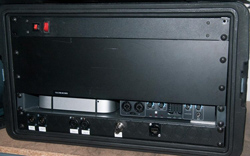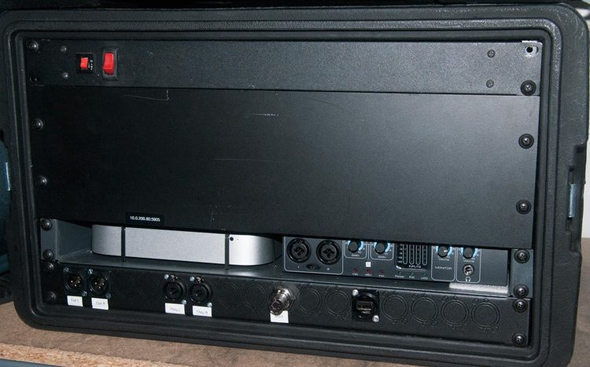So far, we’ve talked about using input sheets to simplify life (here), and drawing from those input sheets to come up with custom cables and snakes that make set up go faster (here).
Sometimes you have a bunch of gear that needs to be placed on and removed from the stage every week.
In those cases, I like to put it in a rack, box or other enclosure to make it go faster.
Don’t let the word “custom” scare you off; these don’t have to be expensive or elaborate boxes.
In fact, the most expensive box on this page was our drum box, and that cost us $30 in materials plus a few hours labor. The other racks we had lying around (and even if we bought them new, neither would be more than $200).
When I say custom, what I really mean is that you’ve considered the needs and tied it all together in a way that makes sense for you. Nothing that I’m showing you here is prescriptive; they are systems we’ve built to address needs we have.
Your needs will be different, so act accordingly. Consider these ideas.
The Piano Rig
Up until a few months ago, we used a Muse Receptor II running Ivory II for our digital piano. We have a Yamaha C7 baby grand on stage, and the C7 comes with a built-in MIDI controller. The piano plays and looks like a real piano, because it is.
Going digital has made it sound better overall because we never have anything else in the piano “mics” because there are no mics—it’s all digital, all the time.
Ivory II sounds great, and with some tweaking, our players have come to enjoy playing on it. At least they did until the Receptor stopped booting. I decided to replace it with a tricked out Mac Mini.
I bought the $599 version, a 2.3 GHz Core i5, then loaded it up with a 240 GB 6G SSD from OWC, and 8 Gigs of RAM. It now boots from off into Ivory in 21 seconds. Not bad.
For output, we use a Focusrite Saffire 24. As you can see, we have plenty of room in this rack. I’m using a 6-space rack because, well, that’s what we had lying around. Someday, I may order a 4-space and save some room.
At the back of the rack, I’ve Velcroed a Radial ProD2 DI. Short 1/4” cables run from the Saffire to the DI, and we wired the output of the DI to the front for easy access.
The Mac is strapped to a rack shelf with a series of crossed zip ties. I was going to use Velcro, but I didn’t want to muck up the bottom of the Mac. Some companies make special racks for Minis, but I don’t mind this (and I’m kinda cheap). I used Velcro to mount the Saffire, however.
Below is our I/O panel. From the left, we have stereo line out, a set of combo jacks that come off the through ports on the DI, MIDI in and USB. We don’t normally need the USB, but once in a while we do have to do some maintenance on the Mac, so it’s easier to plug a keyboard and mouse in. We have a VGA cable out back for the monitor.
The Mac is set to turn on after power loss, so when we turn on the power to the rack, it simply boots up into Ivory Standalone. We shut it down using a VNC client. The whole thing weighs under 10 pounds, so it’s easy to carry out to stage, and lock back up after the weekend is over.






















